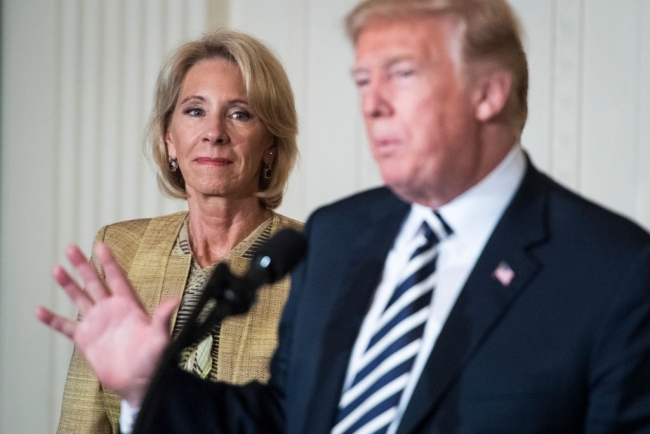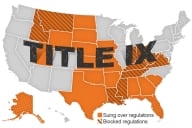You have /5 articles left.
Sign up for a free account or log in.

Secretary of Education Betsy DeVos listens as President Donald J. Trump gives remarks at the National Teacher of the Year reception in the East Room of the White House on Wednesday, May 2, 2018, in Washington, D.C.
Getty Images
WASHINGTON -- President Trump on Monday called for a $5.6 billion, or 7.8 percent, cut in Department of Education funding and reductions for most core funders of academic research, but also proposed a nearly $900 million increase in career and technical education funding that U.S. Education Secretary Betsy DeVos called “perhaps the largest increase in CTE ever.”
In proposing education cuts, as he has every year of his presidency, Trump reproposed several ideas that have been rejected by Congress, including eliminating the Public Service Loan Forgiveness and Supplemental Educational Opportunity Grant programs, and giving campus financial aid administrators greater latitude to limit loan borrowing by individual students.
The proposal, however, did offer some new ideas, including capping graduate student and Parent PLUS loans.
However, the proposal is just that, a proposal, U.S. Education Department officials acknowledged during a briefing on the budget.
Congress each year has passed a budget spending far more than Trump proposed, including last year when Congress spent $72.7 billion on education, compared to the administration’s $64 billion proposal, said Jim Blew, the department’s assistant secretary for planning, evaluation and policy development.
Democrats who control the House didn't seem inclined to go along with Trump's proposals. Rep. Bobby Scott, a Virginia Democrat who chairs the House education committee, said in a statement the proposal "makes college more expensive for students by eliminating the Public Service Loan Forgiveness (PSLF) program and cutting vital sources of financial aid for students from low-income families."
In blasting the proposal, James Kvaal, president of the Institute for College Access & Success, noted the near certainty the proposal will not be approved by House Democrats, who are proposing to increase the size of the maximum Pell Grant and make community college free.
"Students can console themselves that this budget is here today, gone tomorrow," he said. "In fact, Congress is now considering substantial increases in student aid. The deep cuts proposed in this budget should be quickly forgotten."
According to an analysis by the liberal think tank Center for American Progress, the administration would cut more than $2 billion next year in federal student financial support, mostly by bringing back proposals to eliminate programs like subsidized Stafford Loans, freeze the maximum Pell Grant for the next decade and cut $630 million from the federal work-study program.
Among the new ideas were two intended to set “sensible annual and lifetime loan limits for graduate and parent borrowers,” a budget document said. It would limit Parent PLUS loans for undergraduate students to $26,500. Dependent undergraduate students would be eligible to borrow an additional amount, up to $57,500, depending on the parents' eligibility for additional borrowing.
In 1992, Congress removed caps on lending, allowing parents to borrow up to the full cost of attendance after passing a minimum credit check. A report last April by the Urban Institute and New America found the loan program frequently issues debt to parents with little chance of successful repayment, and functions as a “no-strings-attached” revenue source for many colleges.
Graduate students, under the proposed budget, would also not be allowed to borrow more than $50,000 annually, or $100,000 in aggregate. The proposal would also consolidate graduate student borrowing under one loan program with the same terms as Graduate PLUS loans.
In addition, the budget proposal would make incarcerated prisoners eligible for Pell Grants. But Monique Ositelu, senior policy analyst for higher education at New America, said only prisoners due to be released within five years would be eligible. She said in a Twitter post that the five-year limit would disproportionately exclude younger men of color.
The Outlook for Science Research
The Trump administration, in budget documents, touted increases in some types of federally funded research, including an additional $830 million, or 70 percent, in National Science Foundation funding for artificial intelligence-related grants and interdisciplinary research institutes. But associations representing public and private research universities and medical colleges criticized proposed cuts in other research areas.
“The administration’s Fiscal Year 2021 budget request falls far short of the investment needed to secure the U.S.’s position as the world’s preeminent economic power,” Association of Public and Land-grant Universities president Peter McPherson said in a statement. “At a time when our global competitors are doubling down in investments in education and research, we can’t afford to fall behind,” he said.
The proposal would cut overall research funding to the NSF by 7 percent, 17 percent from the Department of Energy’s Office of Science, and 7 percent from the National Institutes of Health.
“While the president’s proposed FY21 budget prioritizes some areas of research -- such as artificial intelligence -- it also contains deep funding cuts and policy proposals that could harm America’s position as the world’s leader in research, science, and higher education,” echoed Association of American Universities president Mary Sue Coleman in a statement.
In proposing the increase in funding for technical and career education, the administration said in a budget document it would support a "commitment to preparing students to succeed in today’s competitive, rapidly changing economy, and answer the ever increasing needs of a booming economy." Touting it at the briefing, Scott Stump, the Education Department’s assistant secretary for career, technical and adult education, said CTE funds have only increased by an average of 1.6 percent annually over the past four decades.
Kermit Kaleba, managing director of policy at the National Skills Coalition, though, called the budget proposal “a mixed bag for our nation’s workforce.” The increase in CTE funding “will go a long way towards helping more students, including adult learners, get the skills and credentials they need to succeed in a 21st century economy,” Kaleba said in a statement. He also praised a proposal to expand Pell Grants to short-term programs.
But he criticized proposed cuts to food stamps and welfare funding, as well as the imposition of a work requirement to receive Medicaid.
Senator Lamar Alexander, chairman of the Senate education committee, in a release, praised aspects of the budget proposal, including the increase in CTE funding.
But he called them "budget suggestions," and noted that “under the Constitution, it is Congress’s job to set spending priorities and pass appropriations bills.”
Advocates for the humanities and the arts were almost certainly finding relief in that constitutional power-sharing arrangement Monday. The administration's budget proposed giving the National Endowments of the Humanities and of the Arts just enough money ($33 million and $30 million, respectively) to begin winding the agencies down.
Congress has ignored those requests in recent years and actually gave the agencies increases last year.








